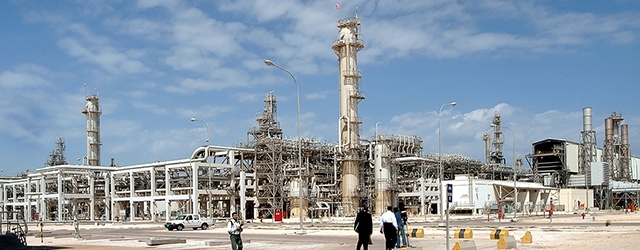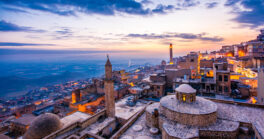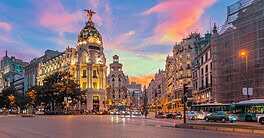The world’s biggest LNG producer is finding ways to bypass a Saudi-led blockade—and even to turn the economic challenge in its favor.

Qatar, the world’s leading producer of liquid natural gas (LNG) and wealthiest nation by per capita GDP, has rebounded from the blockade imposed in June last year by Saudi Arabia, the United Arab Emirates, Bahrain and Egypt. New trade routes have opened up. And Qatar has enacted measures to bolster investment, and a new law, on the cusp of implementation, allowing up to 100% foreign ownership in most sectors outside of banking and insurance.
“Overall, the blockade has helped to build resilience and provided a platform for growth for Qatar going forward,” says Abdulla Mubarak Al-Khalifa, acting group CEO of Qatar National Bank, one of the largest banks in the Middle East.
Continued investment and infrastructure spending to support construction projects related to the 2022 FIFA World Cup and National Vision 2030—a blueprint that Qatar launched in 2008 guiding the state’s economic, social, human and environmental development—“were the key drivers of nonhydrocarbon growth, which is on track to register 5% growth in 2018. The manufacturing sector also contributed significantly, as projects aimed to achieve greater self-sufficiency and food security started to take effect,” Al-Khalifa says.
While imports initially took a hit when the blockade was imposed, they have since recovered to former levels. Critical exports of oil and gas were unaffected.
“Qatar’s economy has pulled through the diplomatic crisis with Saudi Arabia and its allies, and growth will strengthen over the coming quarters as oil output is raised,” says Jason Tuvey, senior emerging-markets economist at Capital Economics.
Even Saudi Arabia’s Crown Prince Mohammed bin Salman, a vocal critic of Doha, admitted at an October investment conference in Riyadh that “Qatar, despite our differences with them, has a very strong economy.”
Prioritizing FDI
Foreign direct investment (FDI) is central to Qatar’s strategy. The amended law on FDI, widely expected to be implemented by the end of the year, is a key development to come out of the blockade, focusing on the industrial, agricultural, information technology, education, health and tourism sectors, Tuvey says.
“We also see the Qatar Financial Center and free zones as platforms and levers to support the incubation and evolution of this new law and new direct investment,” Al-Khalifa says. “This will contribute to private-sector development in Qatar.”
Qatar has allocated $3 billion to attract foreign companies to its free zones and an additional $2 billion to draw multinationals to its financial center, in direct competition with Dubai. As a result, Qatar could become a hub for re-export to countries such as Iraq, Pakistan and Turkey.
Rising oil prices are another factor that continues to smooth the small Persian Gulf state’s economic path through the blockade. “The recent increase is expected to continue to supplement export receipts,” says Bassel Gamal, group CEO of Qatar Islamic Bank, “while increased government revenue should allow infrastructure projects to continue unchanged.” The share of Islamic assets in the local banking sector reached 25.2% at the end of August, up from 21% at the end of 2010.
“The favorable local economic environment, improving legislation, and proper monitoring by the Qatar Central Bank provided a strong growth platform matched with a conservative risk-management policy for the banking industry,” Gamal says. “In addition, a central Shariah board under the central bank has an advisory role for new guidelines and instructions to the Islamic banks as well as acting as a supreme council for all debates and issues related to Islamic banks.”
“Qatar’s economic foundations remain strong, with healthy, stable credit ratings, large sovereign reserves and an economy demonstrating sustained GDP growth,” says Joseph Abraham, group CEO at Commercial Bank of Qatar. “The banking system has adjusted quickly to the blockade.”
The new FDI law will make investment in Qatar much simpler for foreign businesses, Abraham says, predicting that all sectors of the economy will benefit. Commercial Bank stands to gain from strong bilateral relations between Qatar and Turkey, he adds. Qatar has pledged $15 billion of investments and deposits in Turkey, which has helped to steady the Turkish lira.
Qatari banks, too, are building closer relationships with friendly countries in the region. Case in point is Commercial Bank’s acquisition of Turkey’s Alternatif Bank, a mid-sized institution, in 2013. “We have the right experienced management team on the ground to manage the volatility in the economy, and we remain confident in the long-term future of Turkey,” Abraham says. “We are also increasingly looking at opportunities in Oman, thanks to Qatar’s strong relationship with that country and our strategic partnership with the National Bank of Oman, which is the second-largest bank in the country.”
National Vision
Major projects Qatar is pursuing as part of National Vision 2030 include the Bul Hanine oilfield redevelopment by Qatar Petroleum, with an estimated cost of $11-$12 billion; and the Qatar Integrated Rail Project, which includes the Doha Metro network, officially opening in 2020.
Qatar’s planned multibillion-dollar LNG expansion over the next six years will have a major impact on the economy, according to a report by Rory Fyfe, managing director at UK-based MENA Advisors. Qatar plans to grow LNG output by about 30% by 2024 at a cost of up to $40 billion. The cleanest-burning fossil fuel, LNG is enjoying growing demand in Asian countries, particularly China.
“Along with a boost from the Barzan gas project [a joint venture of Qatar Petroleum and Exxon Mobil] and the 2022 FIFA World Cup, the LNG expansion should provide a positive boost to Qatar’s GDP growth throughout the 2020s, with overall growth just touching double digits around 2025-26,” says Fyfe in the report.
“The challenge for the authorities will be to make this growth stick [by successfully implementing their measures to improve the business environment],” he concludes. “If Qatar can seize the opportunities presented by a booming economy in the 2020s, its ephemeral 2030 vision of a knowledge-based economy may actually become one step closer to a concrete reality.”
Given the government’s so-far-successful response to the blockade, Moody’s Investors Service in July raised Qatar’s sovereign issuer rating to stable from negative. The government’s response “demonstrates policy effectiveness and coordination between public-sector entities, as well as a strong institutional capacity to manage crises,” the rating agency said. However, Moody’s criticized “the limited scope, timeliness and frequency of Qatar’s official economic statistics, including fiscal accounts, the real estate sector, the structure of the external debt, and the size and composition of the government’s offshore assets managed by the Qatar Investment Authority.”
In October, nevertheless, Moody’s also changed its outlook for Qatar’s banking system to stable from negative, reflecting the resilience of the economy: “Tangible common equity at Qatari banks will … remain stable at 15.5% of risk-weighted assets, driven by a combination of credit growth and profit retention. Qatari banks’ capital ratios remain resilient even under our high-stress scenario.” Higher oil prices should alleviate pressure on domestic funding, which has been tight since 2014, Moody’s concluded.
Looking Forward
Capital Economics forecasts GDP growth to strengthen to 3.3% this year and 4.3% in 2019. “However, we expect that activity in the nonhydrocarbon sector will stay weak by the standard of the past decade,” Tuvey says. “Qatar will experience a prolonged period of deleveraging following the past decade’s credit boom, weighing on credit growth.”
Some sectors of the economy are still struggling, including tourism (despite relaxed visa requirements) and real estate, where the blockade has prolonged a downturn, Tuvey notes. Bolstering real estate, the cabinet has approved a new law allowing foreigners to own property in Qatar, which could be of particular benefit to some of the approximately 650,000 foreign workers from India who reside in the country.
The travel sector is continuing to adjust. Qatar Airways reported a loss of $69 million in fiscal year 2018, ended March 31, following a profit of $541 million in the previous 12 months. “This turbulent year has inevitably had an impact on our financial results, which reflect the negative effect the illegal blockade has had on our airline,” CEO Akbar Al Baker said in a statement.
The airline is finding channels to replace the lost revenue, however. While it lost access to 18 cities in the blockading nations and has been forced to reroute its flights over Turkey, Iran and Oman, it has since launched 24 new destinations.
Considerable financial buffers and sound economic policies have also helped Qatar absorb the shocks. But the achievement of National Vision 2030’s goal of a diversified, knowledge-based economy will require strong coordination among Qatar’s major institutions, both public and private, says QNB’s Al-Khalifa.
“The growth of the private sector, and specifically of small and medium-size enterprises [SMEs], is key to realizing this vision, which requires an increasing contribution from the private sector,” he says. Among the steps the government has taken to boost the private sector are efforts to nurture SMEs and a soon-to-be-introduced public-private partnership model for large-scale development projects.
“QNB has continued to build on its successful launch of its SME unit as a one-stop shop,” Al-Khalifa says. “We are supporting a number of private-sector initiatives to make Qatar more self-sufficient in the areas of food production, logistics and manufacturing to ensure long-term economic sustainability.”
Transportation and logistics firms are already benefiting from the increase in the volume of trade arriving directly at Qatar’s new Hamad Port, Al-Khalifa notes. In addition to expanding LNG production, several large projects will continue after the 2022 World Cup, including expansion of Qatar integrated rail and Hamad Port and the Lusail “smart city,” which aims to become one of the world’s most technologically advanced cities thanks in part to a deal between Qatari Diar Real Estate Investment and Vodafone Qatar announced earlier this year. The telecom plans to build a high-speed fiber network across an area of more than 38 square kilometers to serve Lusail.
The planned expansion of the North Field—where the majority of Qatar’s natural gas is located—will also require considerable investment, which is expected to drive additional construction activity after the completion of the World Cup stadiums and associated infrastructure, Al-Khalifa says.
There is plenty planned to sustain Qatar’s economic growth.
|
|
2017 |
2018* |
2019* |
2020* |
| GDP | 1.6 | 3.3 | 4.3 | 2.3 |
| Oil GDP | -1.1 | 2.0 | 4.0 | 0.5 |
| Non-Oil GDP | 4.2 | 4.5 | 4.3 | 4.0 |
*Projected.



